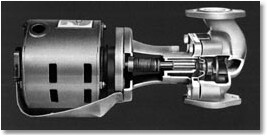Existing Conditions
<Assuming non-residential occupancy.>

The existing domestic hot water recirculation pump operates continually to deliver hot water to all fixtures in the facility. It operates even when the building is unoccupied, resulting in excess electrical consumption at the pump, and unnecessary pump wear. It also reduces heat loss from the distribution piping, which can account for up to 20% of total energy used for DHW heating.
Retrofit Conditions
A timer should be installed, and the pump scheduled to turn off during unoccupied periods. This will reduce pump electrical consumption, and will also eliminate heat loss from the DHW distribution pipe loop at night.
Further Benefits
The lifespan of the pump increases due to the introduction of a daily duty cycle.
Application Details
This can be most easily implemented with a standalone timer. Use a 7-day timeclock to allow for a different occupancy schedule on weekends. DHW recirculation timing can also be added to an existing building automation system where one exists.
Issues and Concerns
If a building occupant needs hot water during shutdown, he must run the tap long enough to displace all cool water in the pipes leading to the fixture. Not only will this result in complaints it will also waste a significant amount of water. Make sure the pump is only shut off outside of times when hot water is needed.
References
Conforms to recommendations in "Energy and Water Efficiency in Multi-Unit Residential Buildings", Canada Mortgage and Housing Corp.
Analysis
{[Pump Size (watts)÷1000] x [hours/week operation] x [52 weeks] x [$/kwh]} - {[Pump Size (watts)÷1000] x [NEW hours/week operation] x [52 weeks] x [$/kwh]} = $/year saved
*1 hp = 746 watts
*$/kWh usually = $0.06 - $0.1 / kwh
Save 8 Hours/day Example:
{[1/3hp (0.224 kW)] x [168 h/w] x 52 x 0.1} - {[1/3hp (0.224 kW)] x [112 h/w] x 52 x 0.1}
=$195.69 - $130.46
=$65.23/year, OR $7.70/year for every hour/day saved.
As a rule of thumb, A typical 7 day timer costs $150, and labour costs $150.
300 ÷ 65.23 = 4.6 year simple pay back.